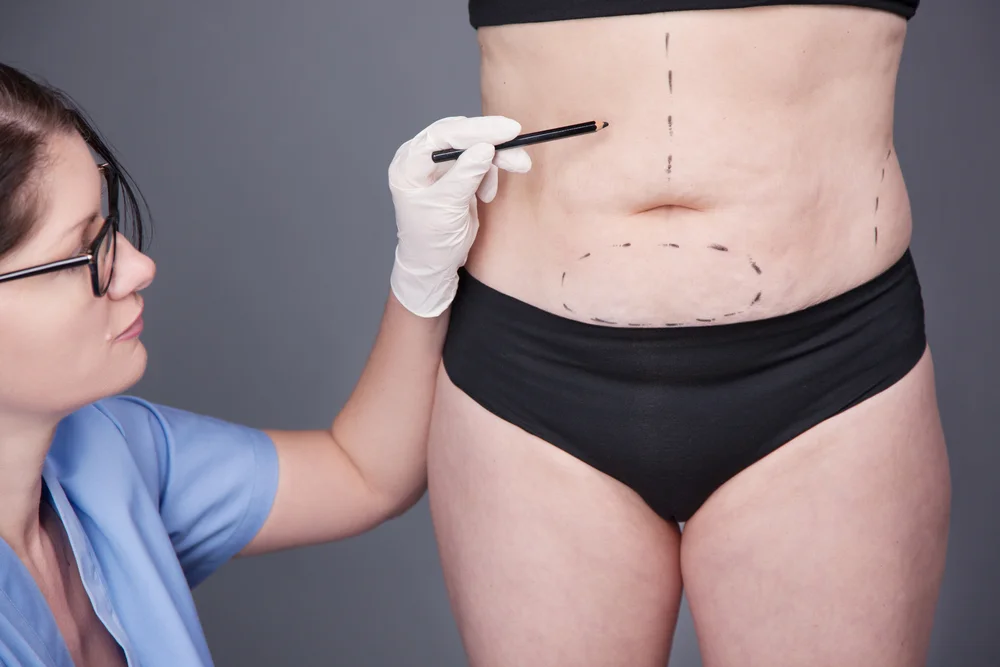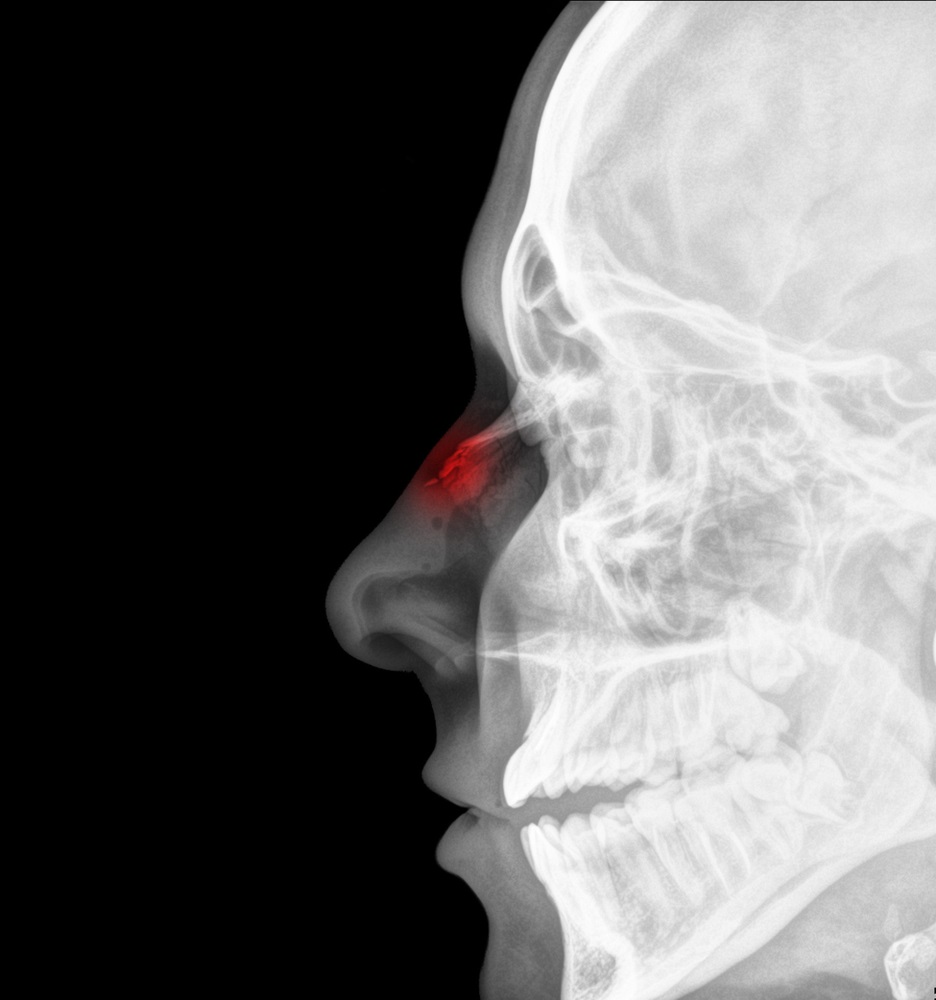Do you wish you could discard your mom jeans and reclaim your pre-baby body? A mommy makeover can help dramatically transform and re-contour your silhouette by combining various surgical procedures.
What Is a Mommy Makeover?
While motherhood represents one of the most gratifying and rewarding life changes a woman can experience, the physical changes that accompany it are not always so welcome.
The demands of bearing children, breastfeeding and caring for a baby can take a toll on the body, leaving stubborn pockets of fat around the abdomen, loose skin, sagging breasts, and stretch marks. A mommy makeover offers women the chance to reverse these changes to their bodies and regain self-confidence.
Dr. Phillip Haeck, former President of the American Society of Plastic Surgeons, notes the growing popularity of the procedure:
“Today women are not afraid to admit that they love their children, but they wish their bodies looked the way they did before their pregnancies. And they’re not afraid to acknowledge that they may need a little help beyond a healthy diet and exercise. In the past we saw a lot of women in their 50s getting these types of procedures. But now we are seeing young mothers in their 30s coming in for procedures such as tummy tucks and breast lifts. They don’t want to wait years to re-establish how they used to look. They want their pre-baby bodies back now.”
Enhancing Self-Esteem
Research has shown that changes to the body caused by pregnancy and motherhood can negatively impact on the self-esteem and body image of many women. In a 2009 study of 506 mothers published in Women and Health journal, scholars investigated mothers’ perceptions of their bodies from delivery to 9 months after giving birth. The results demonstrated that body dissatisfaction among the mothers increased significantly 9 months after the birth of their child.
Pregnancy and childbirth resulted in dramatic changes to women’s body shapes and sizes, with women more dissatisfied with their postpartum bodies than their pre-pregnancy or late pregnancy bodies.
A 34-year-old mother of two from Virginia who recently undertook a mommy makeover explained how motherhood had negatively impacted her physical appearance:
“As a mother of two, I tend to put my children first all of the time. I look at their needs and do my best to accomplish everything they need or want. After breastfeeding for a total of 1.5 years, my boobs became unrecognizable. The ligaments and the skin stretched, making my breasts spill over in the bra and fall down so low that it wasn’t funny anymore. And gravity didn’t help either… for my entire body actually, tummy too.”
Body dissatisfaction among moms has been linked to eating disorders, poorer mental health, greater weight gain, a decreased likelihood of breastfeeding, depression, and psychological distress. The 2009 study concluded that it was vital to find ways to educate women about normal postpartum weight and body changes, and also facilitate ways of enhancing self-esteem and body satisfaction among mothers.
For many new moms, a mommy makeover represents an empowering way to reconfigure the body, restoring it to its pre-pregnancy shape. The results are often pleasingly subtle rather than startling, and the procedures involved in the mommy makeover can be staged in phases so you do not need to undergo all the surgery at once.
The beauty of the mommy makeover is that it is available to moms who are still nursing their bundle of joy, and to moms whose fledglings have left the nest. Your surgeon can help you devise the perfect treatment plan according to the type of cosmetic work you would like carried out, the quantity of time you can spend recovering, and your budgetary constraints.
Ideal Candidates
A wide range of women undergo mommy makeovers: some are career-driven professionals who do not want to look matronly in corporate attire, others are young moms who want their external appearance to reflect the youthful exuberance and energy they feel inside.
Women may choose to undergo mommy makeover procedures to address:
- Excess abdominal fat that cannot be shifted through weight loss or exercise
- C-section scarring
- Unhappiness with their postpartum body shape
- Diminished breast volume
- Sagging breasts
- Stretched skin around the abdomen
- Weakened or separated abdominal muscles as a result of multiple pregnancies (diastasis recti)
- Lack of contour or shape around the torso or mid-section
Generally, the best candidates for a mommy makeover are women who have experienced the rigors and demands of childbirth and childcare. Good candidates should also:
- Be of sound physical, mental, and emotional health
- Have achieved a stable post-baby weight with which they are satisfied
- Have no pre-existing health conditions that may impact on the efficacy of the surgery or recovery time
- Be non-smokers, or have quit smoking at least six weeks prior to surgery
- Have realistic expectations about what surgery can achieve
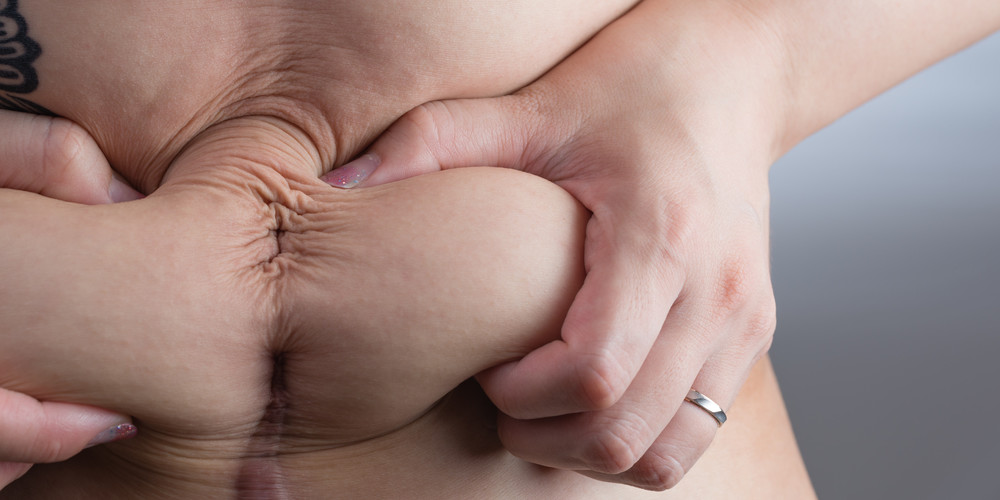
RELATED: Fixing the C-Section Pooch — What Surgery Entails
Mommy Makeover Procedures
Mommy makeovers are unique because they engage a selection of procedures that are customized to provide the best results for your body shape and aesthetic goals.
Most commonly, a mommy makeover involves what has been referred to as the ‘trifecta’: abdominoplasty, lipoplasty and breast rejuvenation.
Your surgeon will talk to you about the outcome you would like to achieve from surgery, what is feasible and realistic, the types of surgical procedures that will be most appropriate for your needs and scheduling considerations. Some women carry out multiple procedures in one session, while others may choose to stage their surgery in phases, according to budgetary or childcare constraints.
Miami cosmetic dermatologist Dr S. Manjula Jegasothy recommends less invasive procedures with minimal downtime for new moms. “It’s generally in alignment with what my patients request as they’re busy women with new babies! They don’t have time for invasive treatments like tummy tucks where they’re out of commission for weeks.”
For women with older children, more extensive procedures may be more feasible.
Tummy Tuck
Some women may choose to undergo a full tummy tuck, also know as an abdominoplasty. The procedure:
- Removes excess skin
- Repairs separated abdominal muscles
- Addresses unsightly stretch marks
- Tightens the skin and muscles of the upper and lower abdomen.
Other women may not require such extensive tummy work and elect to undergo a mini tummy tuck instead, which trims excess skin and firms the lower abdominal muscles.
Liposuction Tummy Tuck
A lipo tummy tuck offers a less invasive alternative for women who have excess subcutaneous fat, but minimal abdominal laxity. The lipo tummy tuck:
- Eradicates stubborn pregnancy fat accumulations
- Tightens areas around the abdomen
- Contours the stomach area with precision
Liposuction can also be used around the thighs, hips and buttocks to remove excess fat.
Breast Rejuvenation
Breast rejuvenation encompasses the range of procedures that women may undergo to restore their breasts to pre-pregnancy appearance. Procedures may include:
- Breast lift, also known as mastopexy surgery, raises sagging breasts, restoring perkiness.
- Breast reduction decreases breast size and removes excess breast skin. This procedure is suitable for women whose breasts have become enlarged as a result of pregnancy, causing back pain or neck pain from excess breast weight.
- Breast augmentation, also known as augmentation mammoplasty, increases cup size and restores lost breast volume.
Additional Procedures
Some women may also undergo additional surgery or treatments to complement the above procedures, such as:
- Lower body contouring to remove loose or sagging skin in the thighs, hips or buttocks
- Brachioplasty to trim excess fat from the upper arms
- Brazilian Buttock Lift to contour and enhance the shape of the buttocks, using a combination of liposuction and fat grafting
- Vaginoplasty to strengthen the vaginal muscles
- Blepharoplasty to reduce signs of tiredness and age around the eyes
- Laser treatments to resurface and refresh the facial skin, stimulating collagen production
- Botox to target wrinkles, particularly crow’s feet and the parallel lines between the eyes
- Dermal fillers to restore volume in places where deep lines or wrinkles have developed
When you schedule your first consultation, your surgeon will be able provide expert advice regarding the most appropriate options or combination of procedures for you.
Dr. Sachin Shridharani, a board-certified New York plastic surgeon, explains that more than one consultation may be necessary to ensure the best possible outcome from surgery:
“I meet with all of my patients seeking cosmetic surgery at least twice before their procedure. My recommendations are based on my patients’ plans for future pregnancies. If the patient is at a stable weight, then a breast lift with possible augmentation to restore volume is wonderful. Along with this, liposuction and tummy tuck are transformative procedures that restore a woman’s physique to its pre-baby state.”

RELATED: Mastering the New Mom Makeover
Finding a Surgeon: 5 Important Criteria
Finding a great plastic surgeon to perform your mommy makeover is critical to attaining the results you desire. Carrying out your own research is essential; it will give you an idea of the experience, credentials and training your surgeon should have. To help guide you, here is a checklist of important criteria to keep in mind:
1. Board certification
Plastic surgeons who hold board certification from the American Board of Plastic Surgery (ABPS) are widely recognized to be experts in their field. Achieving certification from this board guarantees the highest caliber of training, patient safety and ongoing education.
Surgeons may also hold professional memberships to pre-eminent surgical organizations such as the American Society of Plastic Surgeons or the American Society for Aesthetic Plastic Surgery. These professional memberships often require board certification as a condition of pre-entry.
2. Specialization in mommy makeover procedures
As outlined above, mommy makeovers typically consist of a combination of abdominoplasty, breast rejuvenation and liposuction. You should seek a surgeon who has training and experience in these procedures, or the specific procedures you wish to undergo.
The surgeon should carry out the procedures frequently, have a range of patient testimonials and before and after pictures on hand as evidence of his or her work to show you.
Ideally, finding a surgeon who is proficient in designing and carrying out mommy makeover surgeries is even better, as they will have greater specialization in conceptualizing and recommending the right combination of procedures to achieve the beautiful overall result you desire.
3. Use of accredited facilities
Surgeons commonly carry out mommy makeover procedures in outpatient clinics, hospitals or day surgery centers. Regardless of where your surgeon opts to perform surgery, the facility should be appropriately accredited or certified. Accredited facilities must meet rigorous national standards for:
- Equipment
- Operating room safety
- Licensed personnel and care staff
- Surgeon credentials
Surgery performed in these facilities has a greatly reduced rate of serious complications occurring (less than 0.5%) and extremely low mortality rates. If your mommy makeover requires several days recuperation, an accredited facility will ensure you receive round-the-clock care from at least two licensed staff members at all times, equipment and medication available to deal with any complications that may arise, along with an emergency plan should you require a transfer to a hospital.
Ask your surgeon if the facility he or she uses has been accredited by one of the following organizations or associations:
- American Association for Accreditation of Ambulatory Surgery Facilities (AAAASF)
- Accreditation Association for Ambulatory Healthcare (AAAHC)
- Joint Commission on Accreditation of Healthcare Organizations (JCAHO)
- A license from the state in which the facility operates
4. Good rapport and communication
Finding a surgeon with whom you can communicate easily, who makes you feel comfortable and provides you with comprehensive and honest answers to questions is vital. A professional manner is paramount, but so are friendliness and accessibility.
You should feel encouraged to ask questions and voice any concerns or worries you may have. A great plastic surgeon will consult with you to create a plan that meets or even exceeds your goals, while managing factors such as budgetary constraints.
Great surgeons will never make you feel that you have to compromise your goals because of cost, nor will they coerce you into treatments with which you are uncomfortable. In addition, they should be transparent and honest about the outcomes you can realistically expect.
5. Positive reviews and recommendations
Dr. Jegasothy recommends asking around your friendship and social circles after you have selected some initial candidates. “Chances are your local friends and family will have been to some of these physicians, so you can get a better feel for their personality and individual style.”
Once you have narrowed your prospective surgeon list down to several options, progressing to the next step often means asking more probing questions to help inform your final decision about which surgeon to choose.
Here are some suggested questions you may wish to ask surgeons you are interviewing:
- What is your area of surgical specialization?
- How many of these procedures have you performed?
- Do you use a board-certified anesthesiologist?
- If a revision or second surgery is required, what is my financial responsibility?
- What is the total price of the surgery, including surgeon’s fees, use of the operating room facility, anesthesia, medical tests and medication?
- Are there any specific complications or risks I may face as a result of surgery?
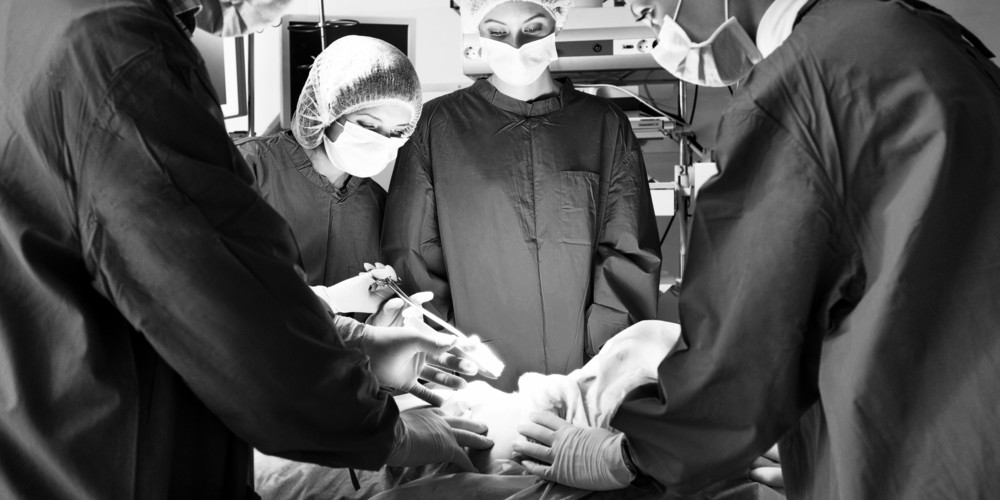
RELATED: Finding a Surgeon You Can Trust
Mommy Makeover Cost: 4 Contributing Factors
Mommy makeovers can vary dramatically in cost, ranging from $10,000 to $30,000. The final cost is determined by several contributing factors:
1. The surgeon’s fees
A well-regarded surgeon with an impeccable reputation can command higher prices than a less experienced surgeon, simply because they are more likely to meet or exceed your expectations. However, paying more for an experienced surgeon also mitigates the likelihood of requiring additional or revision surgeries or procedures, which can be costly.
2. The geographical location of your surgeon’s practice
The geographical region in which a surgeon practices strongly informs their pricing plans. The size of a city, cost of housing and business rental, property tax and utilities reflect on a surgeon’s fees. The general rule of thumb is that surgeons located in busy or very populated metropolitan centers will charge more to reflect higher overhead costs.
3. The surgical facility
The type of surgical facility where your operation will be performed also influences the cost of your mommy makeover. Surgical procedures carried out in private surgical suites tend to offer a more economical alternative to surgery carried out in hospitals or ambulatory surgical centers (also known as outpatient surgery centers or same day surgical centers), which can be more expensive as they have advanced emergency equipment on hand should any complications eventuate.
If your surgeon does use a private surgical suite, ensure that the facility has been accredited or certified by a nationally recognized organisation that guarantees facility safety.
4. The procedures you undergo
For some women, a combination of several smaller procedures may suffice to achieve the desired outcome. Other women may choose to undergo a more extensive overhaul, which means a greater number of procedures.
Also, different procedures have different costs. On average, you can expect to pay the following prices:
Breast rejuvenation
- Breast lift: $6,000-$8,000
- Breast augmentation: $6,000 to $8,000
- Breast reduction: $8,000-$11,000
Abdominoplasty
- Mini tummy tuck: $2,000 to $5,000
- Full tummy tuck: $9,000 to $11,000
Liposuction
- $2,000 to $8,000 per treatment area. The cost varies greatly depending on the area targeted, the quantity of fat that needs to be removed, and the lipoplasty technique engaged.
Arm lift
- $5,000 to $6,000
Thigh lift
- $6,500 on average
Keep in mind that performing two or more procedures simultaneously may mean your surgeon can offer you a discount. For example, undergoing a breast lift and augmentation at the same time could save you as much as 30%. Combining procedures also means one recovery period instead of two. Your surgeon should outline the most effective and financially prudent method of approaching your mommy makeover.
Besides your surgeon’s fee, there are other costs to consider that will contribute to your final total:
- Preoperative appointments or tests
- Postoperative appointments
- Surgical bandages and drains
- Surgical garments
- Antibiotics and pain relief medication
Financing Your Mommy Makeover
If you feel that a mommy makeover is right for you but you have concerns about the financial outlay, there are options available that can render it more affordable. Once you have settled on a surgeon with appropriate expertise and with whom you feel comfortable, he or she can sit down with you to settle on a plan that will allow you to achieve your goals while remaining within your budget.
Many cosmetic surgery clinics offer patients in-office financing plans where you can break the cost up into regular payments. Third-party financing options can also be explored. Talk to your surgeon or the office staff at your surgeon’s clinic so you know what your options are.
Preparing for Surgery
Proper preparation for surgery, particularly if you undergoing a combination of more invasive procedures, can mean the difference between a swift recovery and one marred by complications. A healthy mind in a healthy body, much like the old saying mens sana in corpore sano, means a more positive and pleasant surgical experience.
Pre-Op Instructions
Before surgery, most surgeons will arm you with a list of instructions in order to guarantee the best possible outcome. Here are some of the more common pre-surgical recommendations for women undergoing a mommy makeover.
- Avoid sunbathing for at least two weeks prior to surgery.
- Quit smoking at least 6 weeks prior to surgery, as nicotine can seriously impair skin healing and in some cases, may even result in tissue death (skin necrosis).
- Cease breastfeeding at least 3 months prior to surgery, as breast rejuvenation procedures may impact on your mammary ducts and ability to breastfeed.
- Cease taking any products containing aspirin (Motrin, Advil, etc.), herbal supplements or Vitamin E tablets at least two weeks prior to surgery. Herbal supplements and aspirin have been proven to have blood-thinning qualities which can exacerbate bleeding.
- Inform your surgeon of all medications you are currently taking so they can assess their safety and determine if you should be taking an alternative.
- Ensure you carry out any preoperative tests as specified by your surgeon, and that the results make their way to your surgeon’s office well in advance of your surgery.
- Organize a support person who can drive you to and from surgery, and can stay and care for you postoperatively as you convalesce at home. If you are undergoing more extensive procedures such as breast augmentation and full tummy tuck, it is likely you will need help with walking, going to the bathroom and washing.
- Arrange for someone to help with childcare for at least two weeks after your surgery.
- Stock your pantry so you have an abundance of healthy and nutritious snack foods that are easy to prepare and eat. Hummus, grainy crackers, yogurt, fruit and nuts nourish your body and are easy to consume.
- Clean and organize your house, make sure you have comfortable clothing for your recovery (baggy pants, sweaters or tops with zippers), and find books or films to keep you occupied as you heal. Extra pillows are also useful as they can help you feel comfortable and elevate you as you sleep.
- Fill out your prescriptions and keep pain relief medication on hand should you need it.
- Cultivate emotional well being prior to surgery. Recovery from surgery can represent a tough time as your body will be swollen, bruised and feeling tender. Some women experience post-surgical blues, so being in a positive and emotionally strong mental state prior to surgery is important.
Things to Purchase
- Medication prescribed by your surgeon, such as pain relief and antibiotics.
- A girdle or waist shaping garment that fits snugly (but is not too tight as your abdomen will be swollen after a tummy tuck).
- A compression bra or soft sports bra without underwire if you have had a breast lift.
- Shower chair: after a tummy tuck, it is normal for your core to feel weak, meaning standing in the shower can be difficult.
- Gauze: have plenty of gauze on hand in case of bleeding or weeping from incision sites.
Pre-Surgery Diet
In the weeks leading up to your surgery, commit to a healthy diet. Nourishing your body properly in advance of your mommy makeover has the twofold effect of both promoting successful healing, and also helping you to reach a stable and sustainable weight.
It is vital to avoid weight fluctuations before and after surgery as it can affect your final results, particularly if you are undergoing a mini or full tummy tuck. Eat plenty of seasonal fresh fruits and vegetables, whole grains, lean or plant-based protein sources, and avoid highly processed or refined foods which are generally nutritionally lacking.
Also try to maintain a low-sodium diet as excessive consumption of salty foods can exacerbate swelling.

RELATED: Your Pre- and Post-Surgery Diet
The Day of Surgery
Feelings of excitement, anticipation and fear are all common on the day of surgery. The best way to assuage any anxiety you may have is to ensure you are as ready as possible, with everything organized for your operation and postoperative recovery.
- You will need to observe a preoperative fasting period. Your surgeon will inform you of when you must cease eating or drinking before surgery. It is imperative to observe this pre-operative fasting period as it keeps you safe while you are under anesthesia, minimizing the chance of pulmonary aspiration of the stomach contents occurring.
- Shower and wash your hair the night before surgery, or on the morning of surgery. It can be difficult to wash your hair and shower properly in the immediate period following your mommy makeover. Ensure you do not apply any makeup, moisturizers, lotions, deodorants or creams to your body after your shower.
- Wear comfortable loose-fitting clothing, and tops that have buttons or zippers as they are easier to put on and take off. Remove any jewelry, valuables, piercings, contact lenses or dentures prior to surgery.
Tummy Tuck
During the tummy tuck procedure, a horizontal incision is made in the area between the pubic hairline and belly button. The shape and length of the incision depends on the quantity of skin to be removed. In a full tummy tuck, an incision is made around the belly button.
The weakened abdominal muscles beneath the skin are repaired, the skin is pulled down, the excess skin trimmed, and the horizontal incision sutured closed. A new (elevated) opening for the belly button is created, with the belly button repositioned and stitched into place. In a mini tummy tuck, relocation of the tummy button is not necessary.
Duration of surgery: 1-2 hours on average.
Breast Augmentation
Incisions are made in one of three possible locations: around the nipple (periareolar incision) along the breast crease (inframammary incision) or under the armpit (transaxillary incision). After the incision is made, the surgeon inserts a silicone or saline breast implant beneath the pectoral muscle, or directly behind the breast tissue. The incision is then sutured to close the skin.
Duration of surgery: 2-3 hours on average.
Breast Lift
During the breast lift (mastopexy) procedure, an incision or combination of incisions will be made around the areola, from the nipple to breast crease, or horizontally along the breast crease.
Once the incisions are made, the surgeon reshapes the breasts by lifting and re-contouring the breast tissue, trimming any sagging breast skin and repositioning the nipples and areola to a more elevated position. The incisions are then stitched closed.
Duration of surgery: 3 hours on average.
Breast Reduction
Excess fat, glandular tissue and skin are removed during breast reduction surgery through incisions made around the areola, from the nipple to breast crease, or along the breast crease. Liposuction may also be used to assist in removing excess breast tissue. The areola is sometimes reduced in size by excising skin from its perimeter. Finally, the nipple is relocated to an elevated position on the reshaped breast.
Duration of surgery: 2-5 hours.
Liposuction
Liposuction is carried out through subtle, inconspicuous incisions. A cannula or thin hollow tube is inserted into the incisions and moved in a forward and backwards motion to loosen fat cells. The dislodged fat is then suctioned using a vacuum mechanism attached to the cannula. Sutures may be used to seal the wounds.
Duration of procedure: 2-4 hours on average.
Once your mommy makeover procedures have been completed, you will be wheeled into a postoperative recovery facility where you will be under close supervision until your surgeon releases you to go to an aftercare facility or back home.
Mommy Makeover Recovery Tips
The time it takes to recover from a mommy makeover will depend on the procedures you have undergone. Your surgeon will equip you with a specific list of recovery ‘dos and don’ts’ for you to take home, and you will be asked to return for a follow-up appointment to assess your recovery and progress about five days after surgery.
Dr. Shridharani advises that more extensive mommy makeovers require several weeks of downtime.
“I tell my patients to take their time when recovering from surgery,” says Shridharani. “The first week is marked by tenderness, bruising, and swelling. By week two, most patients are moving around really well. Most of the swelling subsides in the first 2-3 months, but the final results of any surgery take six months to one year.”
The First Week After Surgery
For the first week of postoperative recovery, there are some common precautions and instructions that all patients should follow:
- Have a support person or caregiver with you for at least the first twenty-four hours after your mommy makeover. You may feel very weak or nauseous, and having someone to help you move around the house is vital.
- Ask for help with childcare. If you have very young children, you will require assistance looking after them; potentially for up to three weeks if you have undergone invasive procedures.
- Avoid reaching above shoulder height as this may irritate your breast muscles, and avoid twisting at the abdomen and bending at the waist to protect your tummy area.
- Move around. It is normal to want to sleep and rest for extended periods of time as your body heals, but you need to gently move around to stimulate blood flow and decrease the risk of blood clotting.
- Sleep in an elevated position. This helps to reduce swelling, and prevents you from rolling onto your chest if you have had breast rejuvenation surgery.
- Be prepared for swelling, bruising, and pain. These are all natural bodily responses to surgery and trauma, and represent part of the healing process. Manage your pain with appropriate doses of pain relief as your recovery will be much swifter and more pleasant if you keep pain under control.
- Have your surgeon’s number on hand in case you notice a sudden or excessive increase in swelling, pain, fluid build-up, redness or bleeding; if you begin vomiting, feeling feverish, nauseous or dizzy; or if you experience chest pains.
- Wear any postoperative surgical garments provided by your surgeon. You may be given a surgical bra to hold your new breast shape in place, or an abdominal binder for your tummy tuck recovery. These garments may feel a little awkward but they provide support for your body as it heals, and also reduce swelling through gentle compression.
- Take sponge baths until your dressings and gauze pads are removed. This often occurs three to five days after surgery. You can then shower again as normal, taking care when you wash around the incision sites and thoroughly patting them dry after showering.
Medium to Long-Term Recovery
Most major healing happens in the first two weeks after surgery, but you should expect some residual swelling to linger for longer.
The most essential rule to observe throughout the extended recovery process is to allow your body generous time to heal, and to ask for as much support as you can from loved ones to help out with childcare and domestic tasks. You have made the decision to invest in yourself, so invest as much time as is necessary to recover from surgery and ensure the wonderful final outcome you deserve.
As one 34-year-old mommy makeover patient explains, recovery is a gradual process:
“One of the biggest issues I had with getting a mommy makeover was the recovery time. I still needed to take care of my children. In the subsequent days, I had pain that I needed narcotics for (the doctor will prescribe you some) and it took 2-3 weeks before I no longer needed them. As I started weaning myself off pain killers, I increased my daily activities and after two months things had returned to normal. Now, after a year and few months, my scars are almost gone and I sometimes forget I had so much surgery… except for my new amazing body.”
With respect to returning to everyday activities, most surgeons offer the following advice:
- Work
Most patients are able to return to sedentary or office-based work after 2 weeks. Some women may work part time for two weeks, then return to full-time work after 3-4 weeks. If you have a more active or strenuous job, you will require 4-6 weeks of recovery before you can go back.
Keep in mind, however, that everyone progresses differently. Don’t feel frustrated if you can’t return to work as quickly as you would like; it will take approximately 3 months for your energy levels to return to normal.
- Driving
You cannot drive while taking narcotic pain medication such as Vicodin or Darvocet. You may return to driving when your strength and reflexes feel ready; this is usually 7-10 days after surgery. Make sure that you have someone with you the first time you go out, so they can take over if you do not feel well.
- Working out
Exercise is instrumental to your recovery and maintenance of your results, however, you must be careful not to push too hard nor do too much as your body is healing. The key is to listen to your body: if it hurts, do not do it. You should feel able to tackle brisk walks or stationary cycling 1 week after surgery, light weights 6 weeks after surgery, and more strenuous exercises such as sit ups and jogging 8 weeks after surgery.
- Sexual activity
Sexual activity represents another choice that requires your personal discretion. If it hurts, you should avoid it. Most women feel comfortable and sufficiently healed to return to sex after 3-4 weeks.
Risks and Complications
Invasive surgery always carries a certain level of risk. There are complications that are common to all surgeries, and there are also complications that are specific to each procedural type.
General Risks and Complications
- Delayed wound healing: For some women, healing may take longer than anticipated. If you undergo a series of procedures simultaneously, although you benefit from only one recovery period, your recovery is likely to be somewhat delayed with slower healing. If you were not in an optimal state of health prior to surgery, this may also impact on the speed of your recovery.
- Seroma: An accumulation of fluid beneath the skin can sometimes occur after surgery. Seromas may sometimes require aspiration with a needle to disperse the fluid build-up.
- Bruising (hematoma): Bruising after plastic surgery should be expected. Most bruises subside within a week, but some bruises may persist for six weeks, or in some cases longer. Seek medical advice if your skin remains discolored by bruising long after your recovery.
- Swelling (edema): Swelling or inflammation is normal after surgery, and represents the body’s response to trauma. Fluid-containing proteins, white blood cells and other natural bodily chemicals are released to the wound site to help facilitate healing. Severe swelling should subside within a week, but some swelling may remain for up to six weeks.
- Infection: Infection is one of the more common complications that can arise after plastic surgery. Breaks in the skin, such as incision sites, provide an entry point for bacteria. Diabetics, smokers, individuals on steroids or those with vascular conditions may be more prone to infection occurring. You can decrease the chance of infection by keeping the incision sites clean and dry (use a gentle foaming antibacterial soap when you wash) and taking antibiotics at the first sign of any infection.
- Hypertrophic scars and keloids: While most scars fade over the course of your recovery, some individuals unfortunately experience delayed and noticeable scarring. Hypertrophic scars are thick, rope-like scars that remain within the border of the wound. They may form as a result of tension, but may also form due to genetic predisposition. Hypertrophic scars typically occur 4-8 weeks after surgery and are raised. Keloids are irregular-looking scars that are significantly raised, bumpy and discolored, and extend beyond the borders of the wound like a mushroom. They may form months or even years after surgery. African Americans are more susceptible to keloids than are other ethnicities. There are treatment options for both types of scarring, such as steroid injections to prevent the progression of the thickening.
- Blood clotting: Undergoing a combination of procedures simultaneously increases the risk of a blood clot, because of a longer operative time. This is because you remain immobile for the entirety of the procedure, slowing your blood circulation and making clots more likely. It is essential to walk as soon as you are able for a few minutes, every hour. You may also be prescribed blood thinners such as Lovenox or Eliquis to minimize the risk of clotting.
- Pulmonary embolism: Pulmonary embolism is linked to blood clots. If a blood clot forms in your leg, it could dislodge and travel to your lungs. If you experience any swelling on one leg or shortness of breath after surgery, notify your surgeon immediately.
- Anesthesia risks: General anesthesia is widely used in all types of surgery and is very safe. Nonetheless, the longer you are under anesthesia, there is a slightly increased risk of postoperative confusion, heart attack, stroke or pneumonia. Certain individuals with existing health conditions such as obesity, seizures, obstructive sleep apnea or high blood pressure may also face slightly elevated risks of complications under anesthesia.
- Unsatisfactory results: Sometimes, surgery does not deliver the desired results first time around. You may require additional surgeries, or revision surgeries to correct or address issues. In the hands of a skilled and experienced surgeon, the likelihood of this occurring is notably decreased.
Breast Augmentation
- Incorrect implant size: The implants selected by your surgeon may be too big, or more commonly, too small. This risk, however, can be mitigated by proper pre-surgical consultation. Some surgeons will also encourage you to try on specially designed bras of various volumes to get a sense of how your implants might look and feel.
- Implant malposition: Although it is extremely difficult to achieve absolute symmetry in the breasts — the human body does not tend to be perfectly symmetrical anyway — in some cases if asymmetry is obvious, the breast implants may need re-positioning.
- Capsular contracture: Thick scar tissue forms over the implant, causing the breast to feel hard, and in some cases may distort the breasts and become painful.
- Sensory/nerve changes in the nipple: It is normal for your nipple to lack sensation, or have heightened sensation straight after surgery, but if this persists for months after surgery, it could be indicative of nerve damage.
- Infection: A breast implant is a foreign body that is inserted into your body, so infection is always a possibility. To avoid the chance of infection occurring, surgeons use antibiotics prior to and after surgery, and an impeccably sterile technique. If infection does occur, however, the breast implant may need to be removed.
- Implant rupture: Although this is very unlikely, the implant may rupture, leaking silicone or saline.
- Implant rippling: Ripples in the implant are visible in the breast skin. The chances of rippling occurring are markedly reduced when the implant is inserted beneath the pectoral muscle.
Breast Lift
- Breast asymmetry: This represents the most common post-surgical breast lift complication. It is natural for the breasts to have a certain degree of asymmetry, but it should not be obvious to the unpracticed eye.
- Inadequate volume: If there was a lack of breast tissue prior to surgery, the outcome of a breast lift could appear less than satisfactory. In some cases, breast lifts should be accompanied by implants to create the volume needed to properly lift the breasts.
- Incisional scarring: Scarring is always a side effect of mastopexy surgery and must be accepted. Over time with proper care and scar therapy (scar creams and silicone sheeting), scars can dramatically fade. In some patients, however, scars will not fade so much and may remain visible, raised and red. Other scars on your body can provide a reference point for how you might expect to scar.
Breast Reduction
- Loss of sensation in the nipples and areolae: This should only be temporary, but may persist for up to a year after surgery.
- Difficulty or inability to breastfeed: If a mammary duct is cut and damaged during reduction, the ability to breastfeed may be hindered.
- Breast asymmetry: In certain rare cases this may require surgical work to correct.
Tummy Tuck
- Poor scarring: People heal differently, and visible scars may persist even if the incisions have been sutured properly and due care is taken.
- Blood clotting: There is a heightened risk of blood clotting after abdominoplasty in comparison with other cosmetic surgery procedures. The risk can be decreased by wearing compression stockings and walking around immediately after surgery.
- Contour irregularities in the stomach: Fluid or blood collection along the incision site.
Liposuction
- Contour irregularities: The skin may appear rippled, bumpy or wavy, due to uneven fat removal or poor skin elasticity.
- Numbness: You may experience temporary numbness in the affected area.
- Internal puncture: A cannula that moves too deeply into the body may inadvertently puncture an organ.
- Kidney and heart problems: The movement of fluids in and out of the body can provoke kidney and heart issues.
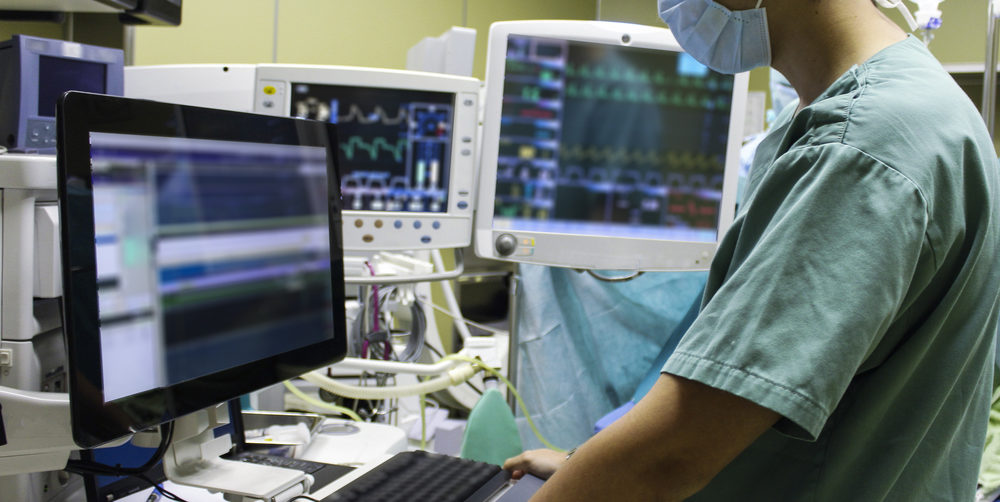
RELATED: Why Medical Clearance Before Surgery Matters
Mommy Makeover Results
You will notice an immediate change in your body following surgery. Your final results may take up to six months to become apparent as your body adjusts to its new contours and swelling subsides; however, most women are able to get a fairly good idea of their results after three months.
As these women share in their postoperative testimonials, the results of a mommy makeover can be incredibly gratifying, beneficially impacting on quality of life and self-esteem:
“Now that it’s been 6 years since my surgery, I can happily say I do not regret it at all. My body looks almost as good as it did when I was in my early 20s. My scars have virtually disappeared (it took about 2.5 years for them to completely fade) and my overall attitude has greatly improved, as I feel like my old self again.”
– Mom, 40, New Jersey
“Post-op, my mommy makeover seemed very superficial to people that didn’t know me very well and I started to feel the need to explain why I did it. That was until I realized I didn’t care what other people thought. Did it make me happy? Yes! Does it affect others negatively? Definitely not! Quite the opposite. People who know me could tell how much happier I was after the procedure. My personality reflected how great I felt post-op.”
– Mom, 34 Virginia
As this mommy makeover patient recommends, returning your body to its pre-pregnancy shape cannot be the result of surgery alone; it must be a compounded effort which also includes changes in lifestyle and perspective:
“My only advice to anyone considering a procedure is that you can’t just rely on a mommy makeover to return your body to the way it once looked. I highly recommend exercising frequently and eating healthy too. Having said that, exercise and eating healthy only goes so far. Also, don’t let other people hold you back. Do what’s best for you. I can’t believe I almost missed my opportunity by worrying about others. Next time I’ll remember to put myself first, because this way I’ll be able to have the mental energy to really take care of everyone that deserves my love and attention.”
– Mom, 34, Virginia
Frequently Asked Questions
Am I a good candidate for a mommy makeover?
The best candidates for a mommy makeover are women who are finished with having children and have reached a healthy and sustainable weight. Good candidates should also be in an excellent state of mental and physical health and have realistic expectations of what surgery can achieve.
What procedures is a mommy makeover comprised of?
Mommy makeovers generally include a combination of the following three procedures: lipoplasty, abdominoplasty, and breast rejuvenation (which encompasses breast lift, breast reduction and breast augmentation). However, based on the patient’s desires and surgeon’s recommendations, mommy makeovers may include other surgical and non-surgical procedures.
How long will it take to see my results?
Positive changes will be visible immediately after surgery. However, it may take up to 6 months to fully appreciate your results.
How long will I need help caring for my family after my mommy makeover?
Recovery may take anywhere from 2 to 6 weeks depending on the procedures you undergo. If you have very small children, seeking support from a loved one or family member to help care for them for at least the first week is a very good idea. Everyday activities like picking up your child will be more difficult than usual.
Can I have more children after a mommy makeover?
Ideally, you should not be planning to have any more children if you undergo a mommy makeover. Although it is possible to have a baby after abdominal contouring and breast rejuvenation, your results will last longer if you undergo surgery when you are done having children.
How long should I wait after pregnancy before considering a mommy makeover?
Most surgeons recommend women wait at least six months after childbirth before undergoing mommy makeover procedures. The body needs time to adjust after pregnancy; for example, some skin laxity will resolve itself after a few months, and pregnancy hormones which affect how the body responds to surgery need time to return to normal levels. Waiting six months also gives you time to reach a healthy post-pregnancy weight.







